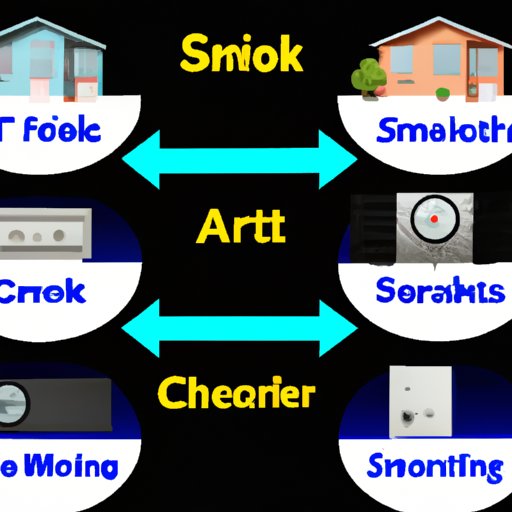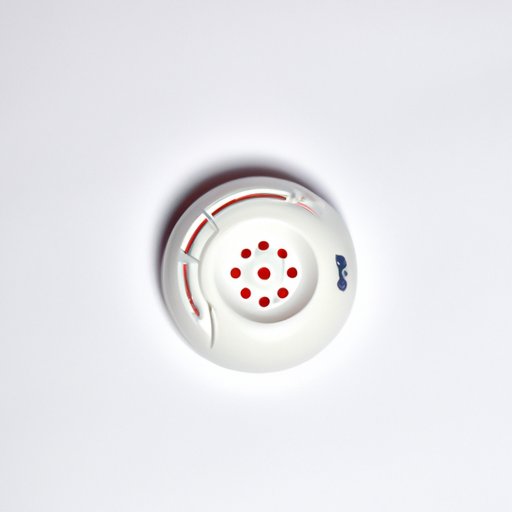Introduction
Smoke detectors are an essential component of any home or business’s fire safety plan. They are designed to detect smoke and alert occupants to potential danger in the event of a fire. In order to ensure effective protection, it is important to choose the right type of smoke detection technology.
This article provides a comprehensive guide to two types of smoke detection technologies – ionization and photoelectric technology – and how to choose between them. It covers the advantages and disadvantages of each type, as well as key considerations when deciding which is best for your building.

Exploring the Different Types of Smoke Detection Technologies
There are two main types of smoke detection technologies available on the market today: ionization and photoelectric. Both technologies have their own strengths and weaknesses, so it is important to understand the differences between them before making a decision.
Ionization Technology
Ionization smoke detectors use a small amount of radioactive material to detect smoke particles. When smoke enters the detector, it disrupts the flow of ions and triggers an alarm. According to a study conducted by the National Institute of Standards and Technology (NIST), ionization smoke detectors are “generally more sensitive to flaming fires” and respond quickly to fast-burning fires.
Photoelectric Technology
Photoelectric smoke detectors use a light source and a light sensor to detect smoke particles. When smoke enters the detector, it scatters the light and triggers an alarm. According to the NIST study, photoelectric smoke detectors are “generally more sensitive to smoldering fires” and respond quickly to slow-burning fires.

How to Choose Between Two Types of Smoke Detection Technologies
When choosing between ionization and photoelectric technology for your smoke detectors, there are several factors to consider. These include your building’s size and layout, your budget, and your level of risk.
Consider Your Building’s Size and Layout
The size and layout of your building will determine which type of smoke detector is most suitable. For larger buildings, such as warehouses and factories, ionization technology is often the best option due to its greater coverage area. For smaller buildings, such as homes and offices, photoelectric technology may be the better choice due to its greater sensitivity to smoldering fires.
Determine Your Budget
Both ionization and photoelectric technology come in a variety of price points, so it is important to determine your budget before making a decision. Generally speaking, ionization technology tends to be more expensive than photoelectric technology, but this does not necessarily mean it is the better choice. Consider both types of detectors and compare prices to find the best option for your needs.
Assess Your Level of Risk
It is also important to assess your level of risk when choosing between smoke detectors. If you live in an area prone to fast-burning fires, such as forest fires, then ionization technology may be the best choice. On the other hand, if you live in an area prone to smoldering fires, such as cigarettes and candles, then photoelectric technology may be the better option.
A Comprehensive Guide to Smoke Detection Technologies
To help you make an informed decision, here is a comprehensive guide to the advantages and disadvantages of both ionization and photoelectric technology.
Advantages and Disadvantages of Ionization Technology
One of the main advantages of ionization technology is its quick response time. According to the NIST study, ionization smoke detectors can detect fast-moving flames within 10 to 30 seconds. Additionally, ionization smoke detectors are relatively inexpensive and require minimal maintenance.
On the downside, ionization technology has a greater false alarm rate than photoelectric technology. This means that they are more likely to trigger false alarms due to dust, steam, and other airborne particles. Additionally, ionization detectors contain a small amount of radioactive material, which may pose a health risk.
Advantages and Disadvantages of Photoelectric Technology
Photoelectric smoke detectors have a much lower false alarm rate than ionization detectors, making them ideal for areas with a lot of dust or steam. Additionally, photoelectric smoke detectors are less expensive than ionization detectors and require minimal maintenance.
The main disadvantage of photoelectric technology is its slower response time. According to the NIST study, photoelectric smoke detectors can take up to 90 seconds to detect fast-moving flames. Additionally, photoelectric detectors are not as effective at detecting smoldering fires as ionization detectors.
Comparing and Contrasting the Two Types of Smoke Detection Technologies
In order to make an informed decision, it is important to compare and contrast the differences between ionization and photoelectric technology. Here are some key points to consider when comparing the two.
Differences in Installation
Ionization smoke detectors are typically installed in the ceiling, while photoelectric detectors are usually mounted on the wall. This is because ionization detectors need to be placed high in order to detect smoke from a distance, while photoelectric detectors need to be placed lower in order to detect slow-moving smoke.
Differences in Sensitivity
Ionization smoke detectors are generally more sensitive to fast-burning fires than photoelectric detectors. However, photoelectric detectors are more sensitive to smoldering fires than ionization detectors. As such, it is important to consider the type of fire risk in your area when choosing between the two.
Differences in Maintenance Requirements
Ionization and photoelectric detectors require different levels of maintenance. Ionization detectors require regular testing and cleaning, while photoelectric detectors only need to be tested once a year. Additionally, ionization detectors need to be replaced every 5–7 years, while photoelectric detectors can last up to 10 years.

What You Need to Know About Smoke Detection Technologies
Once you have chosen the type of smoke detector that is right for you, there are several steps you should take to ensure proper installation and maintenance. Here are some key points to keep in mind.
Ensuring Proper Installation
When installing smoke detectors, it is important to follow the manufacturer’s instructions carefully. This includes using the correct mounting hardware and ensuring the detector is located in an area with adequate airflow. Additionally, it is important to test the detector after installation to ensure it is working properly.
Testing and Inspecting Smoke Detectors
Smoke detectors should be tested regularly to ensure they are functioning properly. This includes testing the battery and the detector itself. Additionally, the detectors should be inspected periodically for signs of wear and tear, such as cracks or corrosion.
Choosing the Right Type of Smoke Detector for You
When choosing a smoke detector, it is important to consider your building’s size and layout, your budget, and your level of risk. Additionally, it is important to compare the advantages and disadvantages of both ionization and photoelectric technology before making a decision.
Conclusion
Smoke detectors are an essential component of any home or business’s fire safety plan. There are two main types of smoke detection technologies available on the market today: ionization and photoelectric. Both technologies have their own strengths and weaknesses, so it is important to understand the differences between them before making a decision.
When choosing between ionization and photoelectric technology for your smoke detectors, there are several factors to consider. These include your building’s size and layout, your budget, and your level of risk. Additionally, it is important to ensure proper installation and maintenance of your smoke detectors. By following these guidelines, you can ensure you have the right type of smoke detector for your needs.
In summary, smoke detection technologies are an important part of any fire safety plan. Understanding the different types of smoke detectors and how to choose between them can help you make an informed decision and ensure your building is safe and secure.
Key Takeaways
- Ionization and photoelectric technology are two types of smoke detection technologies.
- Ionization technology is generally more sensitive to fast-burning fires, while photoelectric technology is generally more sensitive to smoldering fires.
- When choosing between the two, consider your building’s size and layout, your budget, and your level of risk.
- Ensure proper installation and maintenance of your smoke detectors to ensure they are working properly.
(Note: Is this article not meeting your expectations? Do you have knowledge or insights to share? Unlock new opportunities and expand your reach by joining our authors team. Click Registration to join us and share your expertise with our readers.)
